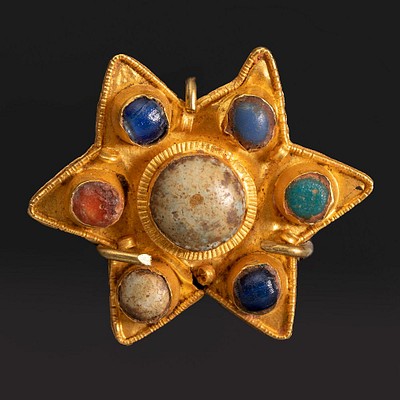TOMÁS MUÑOZ LUCENA (Córdoba, 1860- Madrid, 1943). "Family in a courtyard". Oil on canvas.
Lot 105
About Seller
Setdart Auction House
Carrer Aragó 346
Barcelona
Spain
Setdart Subastas was born in 2004 and is currently the first online art auction in Spain with solidity, prestige and reliability guaranteed by our more than 60,000 users. Setdart has a young, dynamic and enterprising team ready to successfully manage the purchase and sale of art works through custom...Read more
Estimate:
EUR€7,000 - EUR€9,000
$7,526.88 - $9,677.42
Absentee vs Live bid
Two ways to bid:
- Leave a max absentee bid and the platform will bid on your behalf up to your maximum bid during the live auction.
- Bid live during the auction and your bids will be submitted real-time to the auctioneer.
Bid Increments
| Price | Bid Increment |
|---|---|
| EUR€0 | EUR€10 |
| EUR€200 | EUR€25 |
| EUR€500 | EUR€50 |
| EUR€1,000 | EUR€100 |
| EUR€3,000 | EUR€200 |
| EUR€5,000 | EUR€500 |
| EUR€10,000 | EUR€1,000 |
| EUR€20,000 | EUR€2,000 |
| EUR€50,000 | EUR€5,000 |
About Auction
By Setdart Auction House
Dec 21, 2021
Set Reminder
2021-12-21 07:30:00
2021-12-21 07:30:00
America/New_York
Bidsquare
Bidsquare : Córdoba: 2,000 Years of Art
https://www.bidsquare.com/auctions/setdart-auction-house/c-rdoba-2-000-years-of-art-8049
Setdart Auction House sofia@setdart.com
Setdart Auction House sofia@setdart.com
- Lot Description
TOMÁS MUÑOZ LUCENA (Córdoba, 1860- Madrid, 1943). "Family in a courtyard". Oil on canvas. Presents slight restorations and period frame. Signed in the lower left corner. Measurements: 58 x 63 cm; 85 x 88 cm (frame). This work stands out for the luminosity that the artist achieves by using white as a chromatic base, this is complemented with certain flashes caused by orange and red tones, which are arranged both in the characters and in the place described in the work. This type of genre scenes were recurrent in the painting of Tomás Muñoz, who achieved a great recognition by the public thanks to the publication of scenes of this theme in the magazine Blanco y negro, a fact that provided a great diffusion and the approach of his painting to a wide sector of the population. Tomás Muñoz Lucena began his training in the Cordovan school of painting of Rafael Romero Barros. He then entered the recently inaugurated School of Fine Arts in Cordoba, where he coincided with Julio Romero de Torres and Mateo Inurria. Thanks to his talent, he obtained a scholarship from the Provincial Council to study at the San Fernando School in Madrid in 1879. There he will be a disciple of Federico de Madrazo. Again with a scholarship from the Diputación, Muñoz Lucena made a trip to Rome, where he acquired the new impressionist tendency, being in fact considered the first Cordovan painter in this style. In 1881, he took part for the first time in the National Exhibition in Madrid, and three years later he sent from Rome his work "Ofelia", which caused admiration, but was not awarded a prize. Frustrated by this unjust marginalization, undoubtedly due to the fact that his works were not the themes sought by the jury of the National Exhibitions, which valued history themes above all, Muñoz Lucena seriously reconsidered the theme of the works he would send to these competitions. Thus, entering the game of history painting, he sent to the National Exhibition of Fine Arts of 1887 his contribution to the genre, also giving it the "necrophiliac" air that was so much to the taste of the jurors. The painting, magnificent, was entitled "The corpse of Alvarez de Castro", exalting the general who resisted for months the siege of Girona by the French, and was finally awarded a second medal. With this official recognition, Muñoz Lucena's prestige increased considerably, and his successes followed. Again he obtained a second medal in 1890 and, finally, a first medal in 1901 for his painting "Plegaria en la ermita de Córdoba". He also took part in foreign competitions, and in 1900 he was awarded a bronze medal at the Universal Exposition in Paris. He was a teacher from 1894, the year in which he was appointed director of drawing at the Institute of Cordoba, and later he also taught in Granada and Seville. In the last years of the 19th century he also began to collaborate with magazines such as "Blanco y Negro" and "La Ilustración Española y Americana", forming part of the group of illustrators who marked a new path in the graphic arts at the beginning of the 20th century. He retired in 1930, and decided to move to Madrid, where he lived until his death in 1943. In addition to painting, he also devoted himself to illustration, collaborating with magazines such as "Blanco y Negro", to whose first generation he belonged. Works by Muñoz Lucena are kept in the Prado Museum, the Museum of Fine Arts of La Coruña, the Diputación de Córdoba, the University of Granada and the Romantic Museum of Madrid.
- Shipping Info
-
In-house shipping available. Please inquire at admin@setdart.com.
-
- Buyer's Premium



 EUR
EUR CAD
CAD AUD
AUD GBP
GBP MXN
MXN HKD
HKD CNY
CNY MYR
MYR SEK
SEK SGD
SGD CHF
CHF THB
THB















